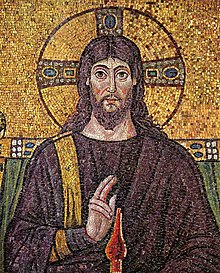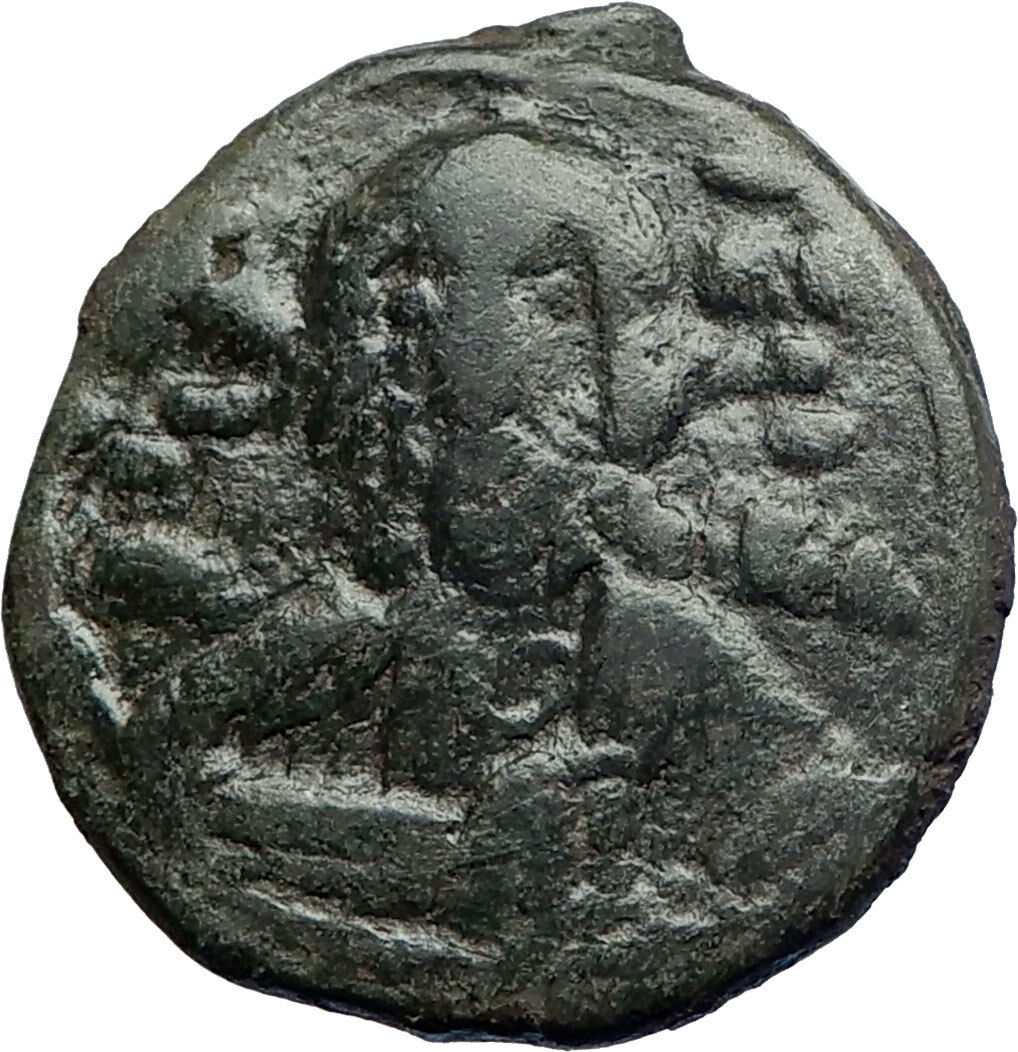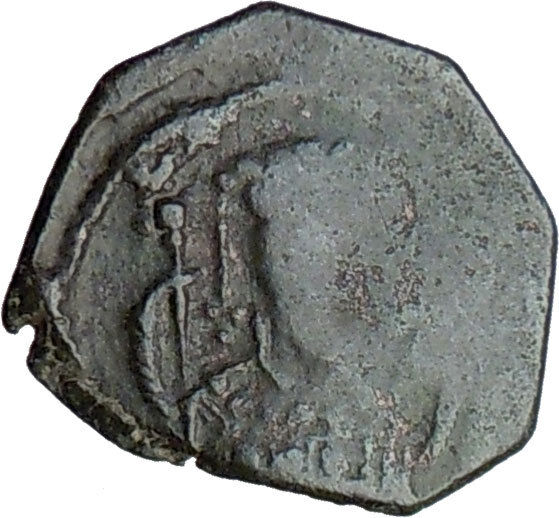|
Byzantine Empire
Anonymous Class
E
Bronze Follis 30mm (6.77 grams) Constantinople mint: 1059-1067 A.D.
under Constantine
X –
Byzantine Emperor: 25 December 1059 – 21 May 1067 A.D.
Reference: Sear 1855
Bust of
Christ
facing, wearing nimbus crown, pallium and colobium,
and holding book of
Gospels
with both hands; to left, IC; to right, XC.
IS XS / bASILЄ / bASIL’ (“Jesus Christ
King of Kings”) in three lines, – + –
above, -u- underneath.
For more than a century, the production of Follis denomination Byzantine coins
had religious Christian motifs which included included
Jesus Christ, and even Virgin Mary. These coins were designed to honor Christ
and recognize the subservient role of the Byzantine emperor, with many of the
reverse inscriptions translating to “Jesus Christ King of Kings” and “May Jesus
Christ Conquer”. The Follis denomination coins
were the largest bronze denomination coins issued by the Byzantine empire, and
their large size, along with the Christian motif make them a popular coin type
for collectors. This series ran from the period of Byzantine
emperors John I (969-976 A.D.) to Alexius I (1081-1118 A.D.). The accepted
classification was originally devised by Miss Margaret Thompson with her study
of these types of coins. World famous numismatic
author, David R. Sear adopted this classification system for his book entitled,
Byzantine Coins and Their Values. The references about this coin site Mr. Sear’s
book by the number that they appear in that work. The class types of coins
included
Class A1,
Class A2,
Class B,
Class C,
Class D,
Class E,
Class F,
Class G,
Class H,
Class I,
Class J,
Class K. Read more and see examples of these coins by reading the
JESUS CHRIST
Anonymous Class A-N Byzantine Follis Coins Reference.
Click here to see all the Jesus Christ Anonymous Follis coins for sale.
Click here to see all coins bearing Jesus Christ or related available for sale.
You are bidding on the exact
item pictured, provided with a Certificate of Authenticity and Lifetime
Guarantee of Authenticity.
Jesus of Nazareth (c. 5 BC/BCE – c. 30 AD/CE), also
referred to as Jesus Christ or simply Jesus, is the central figure
of
Christianity. Most
Christian denominations
venerate him as
God the
Son
incarnated
and believe that he
rose from the dead
after being
crucified
.

The
principal sources of information regarding Jesus are the four
canonical gospels, and most
critical scholars
find them, at least the
Synoptic Gospels, useful for reconstructing Jesus’ life and
teachings. Some scholars believe apocryphal texts such as the
Gospel of Thomas and the
Gospel according to the Hebrews
are also
relevant
.
Most critical historians agree that Jesus was a
Jew
who was regarded as a teacher and
healer
, that he
was baptized
by
John the Baptist, and
was crucified
in
Jerusalem
on the orders of the
Roman Prefect
Judaea,
Pontius Pilate, on the charge of
sedition
against the Roman Empire
. Critical Biblical scholars and
historians have offered competing descriptions of Jesus as a self-described
Messiah,
as the leader of an apocalyptic movement, as an itinerant sage, as a charismatic
healer, and as the founder of an independent religious movement. Most
contemporary scholars of the
Historical Jesus consider him to have been an independent,
charismatic founder of a Jewish restoration movement, anticipating an imminent
apocalypse. Other prominent scholars, however, contend that Jesus’ “Kingdom
of God” meant radical personal and social transformation instead of a
future apocalypse.
Christians traditionally believe that Jesus was
born of a virgin
:529–32
performed
miracles
,:358–59
founded
the Church
,
rose from the dead
, and
ascended
into
heaven,:616–20
from which he
will return
.:1091–109
Most Christian scholars today present Jesus as the awaited Messiah promised in
the
Old Testament and as God, arguing that he fulfilled many Messianic
prophecies of the Old Testament
. The majority of Christians
worship Jesus as the incarnation of God the Son, one of three divine persons of
a reject Trinitarianism
Trinity, wholly or partly,
believing it to be non-scriptural.
Constantine X Doukas or Ducas (Greek:
Κωνσταντίνος Ι΄ Δούκας, Kōnstantinos X Doukas),
(1006 – May, 1067) was emperor of the
Byzantine Empire
from 1059 to 1067.
Reign
Constantine Doukas was the son of Andronikos Doukas, a
Paphlagonian
nobleman who may have served as governor of the theme of
Moesia
.
Constantine gained influence after he married, as his second wife,
Eudokia Makrembolitissa
, the niece of Patriarch
Michael Keroularios
. In 1057, Constantine supported the usurpation of
Isaac I Komnenos
, but gradually sided with the court bureaucracy against the
new emperor’s reforms. In spite of this tacit opposition, Constantine was chosen
as successor by the ailing Isaac in November, 1059, under the influence of
Michael Psellos
. Isaac abdicated and on
November
24
, 1059
,
Constantine X Doukas was crowned emperor.
The new emperor quickly associated two of his young sons in power, appointed
his brother
John Doukas
as kaisar (Caesar)
and embarked on a policy favorable to the interests of the court bureaucracy and
the church. Severely undercutting the training and financial support for the
armed forces, Constantine X fatally weakened Byzantine defences (by disbanding
the Armenian local militia of 50,000 men) at a crucial point of time, coinciding
with the westward advance of the
Seljuk Turks
and their Turcoman allies.
Constantine became naturally unpopular with the supporters of Isaac within
the military aristocracy, who attempted to assassinate him in 1061; he was also
unpopular with the general population, after he raised taxes to try to pay the
army at long last.
Constantine lost most of Byzantine
Italy
to the
Normans
under
Robert Guiscard
, except for the territory around
Bari, though a
resurgence of interest in retaining
Apulia
occurred
under his watch and he appointed at least four
catepans of Italy
:
Miriarch
,
Maruli
,
Sirianus
,
and
Mabrica
. He also suffered invasions from
Alp Arslan
in
Asia Minor
in 1064 and the
Uzes
in the Balkans
in 1065. Already old and unhealthy when he came to power, he died on
May 22
,
1067 and was
succeeded by his young sons under the regency of their mother Eudokia
Makrembolitissa.
|









